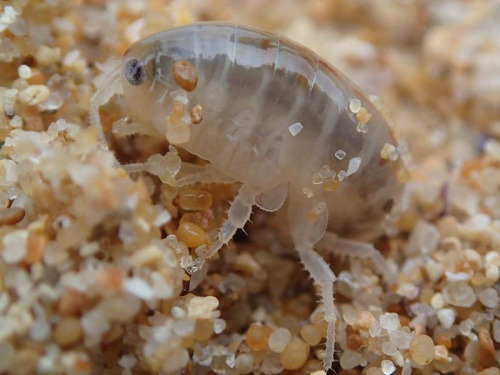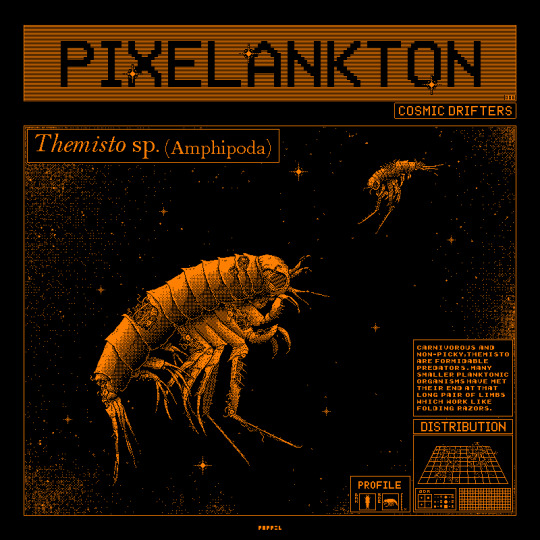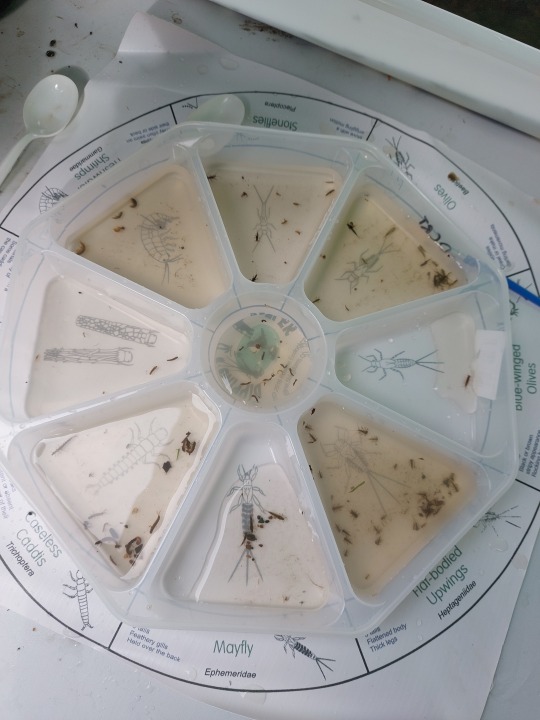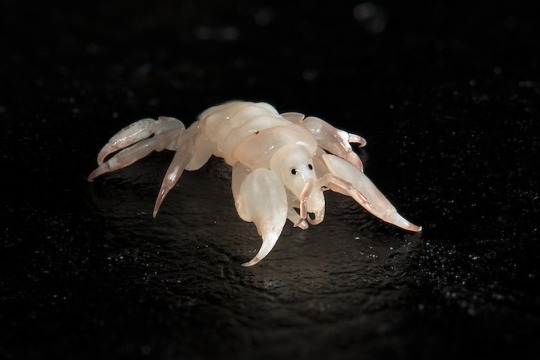#Amphipoda
Text

inkwash bugs
#bflyart#bug art#tardigrada#myriapoda#amphipoda#arachnida#coleoptera#hymenoptera#diptera#lepidoptera#hemiptera#neuroptera#curculionidae#formicidae#cicindelidae#salticidae#chilopoda#scolopendridae#mantispidae#brentidae#scolytidae#isopoda#ligiidae#scelionidae#baeus#caprellidae#psychidae#psychodidae#chrysomelidae#sphingidae
2K notes
·
View notes
Text

Phronima, family Phronomidae, order Amphipoda, Gulf of Aqaba, north Red Sea
This is a genus of small deep sea hyperiid amphipod crustaceans.
Phronima rear their young, and sometimes live in, the empty "tunics" of tunicates (sea squirts), which they kill and eat.
They are also known as "pram bugs" and "barrel shrimp".
photograph by Gil Koplovitz
198 notes
·
View notes
Text
Uncharismatic Fact of the Day
The next time you hit the beach, keep an eye out for sand hoppers! Only 1-2 cm (0.39-0.78 in) long, these tiny crustaceans can jump as high as 40 cm (15 in) or a distance of over a meter (39 in)! Their remarkable leaping abilities come from their tails, which sand hoppers tuck under their bodies and then flick out like a spring board.

(Image: A species of sand hopper, Talitrus saltator, by Eric Walravens)
If you like what I do, consider leaving a tip or buying me a ko-fi!
355 notes
·
View notes
Text

A group of marine amphipods (Anonyx nugax) inside a dead crab
by Alexander Semenov
#no common names whatsoever#crustaceans#amphipods#anonyx nugax#anonyx#uristidae#amphipoda#malacostraca#arthropoda#wildlife: misc
41 notes
·
View notes
Text

Carnivorous and non-picky, Themisto are formidable predators. Many smaller planktonic organisms have met their end at that long pair of limbs which work like folding razors.
#pixelart#illustration#infographic#poster#biology#biopunk#zooplankton#plankton#ocean#cosmos#space#dark#scifi#pop science#amphipoda#themisto#poppel#1bit#pixelankton
835 notes
·
View notes
Text

pictured here: a freshwater scud (Gammarus sp.)
#back at it again actively confusing my fandom moots#pleae vote my scud poll I’m cooking something#halcyonia#polls#scud#bugs#crustacean#amphipods#amphipoda
22 notes
·
View notes
Text
Did river invert sampling today! It was very cool, also got to see some very nice inverts other than the river ones, and maybe some planarians that aren't pictured here since I couldn't get them off the rock I saw them on

#Ecology#Rivers#Zoology#Mayfly#Stonefly#Freshwater shrimp#Caddisfly#Blackfly#Arthropoda#Insecta#Ephemeroptera#Heptageniidae#Ephemeridae#(Some of those were misidentified Baetidae‚ they got moved afterwards)#Baetidae#Ephemerellidae#Trichoptera#Rhyacophilidae#Plecoptera#Diptera#Simuliidae#Malacostraca#Amphipoda#Gammaridae#Photos#Aquatic#Not a reblog
0 notes
Note
Genuine curiosity, what's the difference between isopods and amphipods?
oh hey, i remember this from last semester!
it's right in the name actually! crustaceans in order Isopoda ("single foot") generally only have one kind of appendage on their thorax-- they're pretty much all the same shape and oriented in the same direction. by contrast, crustaceans in order Amphipoda ("both foot") have some pairs of limbs facing forwards and some facing backwards, each with different shapes/uses.
of course, as with any taxonomic group, it ultimately comes down to genetic ancestry/similarity, and simple physiological appearance is not what determines the taxa!
27 notes
·
View notes
Photo

While this species is new to science and lives in one of the remotes habitat in the world, the hadal zone, it is not exempt from plastic pollution, one individual was found to have a microplastic PET (Polyethylene-terephthalate) fiber in its gut. PET is a very common plastic usedto make water bottles, food packaging and fibers clothings. This species was named Eurythenes plasticus after this finding.
Weston et al., 2020. New species of Eurythenes from hadal depths of the Mariana Trench, Pacific Ocean (Crustacea: Amphipoda). Zootaxa
#marine pollution#mariana trench#deep sea#hadal zone#pacific#new species#science#biology#sciblr#scienceblr#marine science#Eurythenes plasticus#Eurythenes
92 notes
·
View notes
Text
not bullshitting it random because you have to understand that amphipoda specifically is a diverse group of small shrimp-like taxa that brood their young in a POUCH the marsupium with no independent larval dispersal stage
with kojima’s very particular fondness for his cryptiobiote, extensive research on marine life, it could absolutely not be a coincidence that the design is alone is mixing BB + amelie + higgs = > carrying life at the depths of the abyss
6 notes
·
View notes
Text
que orden de crustáceos existen en el supra litoral oceánico español
que orden de crustáceos existen en el supra litoral oceánico español
En el supralitoral oceánico español, se pueden encontrar diversos órdenes de crustáceos que están adaptados a vivir en la zona intermareal superior, es decir, en la franja de terreno que se encuentra por encima del nivel de marea alta. A continuación, mencionaré algunos de los órdenes de crustáceos que se encuentran comúnmente en esta zona:
Orden Amphipoda: Los anfípodos son crustáceos pequeños…

View On WordPress
0 notes
Text
Dissecting the Kenhub Atlas: Insights from Editor Mike Pascoe | TAPP 144
Mike Pascoe joins host Kevin Patton in Episode 144 to chat about Mike's experience in editing the new Kenhub Atlas of Human Anatomy. We go behind the scenes to see how this new kind of anatomy atlas was developed. Let's see how those decisions get made and how the learning perspective gets incorporated into anatomy manuals. And we explore diverse representation in anatomy images and why we won't find any eponyms in this atlas. We also have a brief remembrance of our friend David Allard.
00:00 | Introduction
00:45 | Remembering David Allard
04:25 | Introducing Mike Pascoe
06:12 | A New Take on the Human Atlas
19:00 | Debriefing and Predictions Ahead
19:55 | Creating Books
34:25 | Your New Thing
35:44 | More Features of the New Atlas
47:27 | Staying Connected
★ If you cannot see or activate the audio player, go to: theAPprofessor.org/podcast-episode-144.html
🏅 Apply for your credential (badge/certificate) for listening to this episode: theAPprofessor.org/podcast-episode-144.html/#badge
⭐⭐⭐⭐ Please rate & review this podcast so that others can decide whether to give it a try: RateThisPodcast.com/theAPprofessor
❓ Please take the anonymous survey: theAPprofessor.org/survey
☝️ Questions & Feedback: 1-833-LION-DEN (1-833-546-6336)
✔️ Follow The A&P Professor on Twitter, Facebook, Blogger, Substack, Tumblr, or Instagram! @theAPprofessor
📰 Get the once-or-twice-weekly TAPP Science & Education Updates theAPprofessor.org/updates
The light of the heart is hidden in a drop of blood. (Rumi)
Remembering David Allard
3.5 minutes
In this segment, Kevin reflects on the recent passing of a friend and colleague, David Allard of Texas A&M University-Texarkana, who was an exceptional educator and human being. Kevin finds inspiration from David's generosity and commitment to his students and peers.
★ Muscle: A Gripping Story by Roy Meals | TAPP 142 (mentioned in this segment)
★ The One Teaching Strategy That Will Fix Your Anatomy & Physiology Course | TAPP 143 (where I talk about generosity in teaching)
★ Longtime Texarkana College and Texas A&M University-Texarkana biology professor David Allard dies (from Texarkana Gazette) AandP.info/qll
★ Dr David Allard Memorial Service 11-30-23 youtu.be/Gi2ZunUtMxk
★ Two new species of sand-burrowing amphipods of the genus Haustorius Müller, 1775 (Amphipoda: Haustoriidae) from the northwestern Gulf of Mexico (journal article in Zootaxa by David Allard's former student Zachary Hancock, who named one of the new species after David [Haustorius allardi]) https://aandp.info/rzp
★ Dr. David & Ellen Allard Endowment Scholarship (in case you want to make a donation in David's memory) tamut.edu/give/index.html
Please rate & review The A&P Professor—it helps others decide whether to give us a try! 😁
★ RateThisPodcast.com/theAPprofessor
Introducing Mike Pascoe
2 minutes
In this segment, we introduce the guest for the episode, Mike Pascoe, who is an associate professor of anatomy at the University of Colorado Anschutz Medical Campus. Mike is involved in developing and delivering anatomy curricula to various student groups and has a research interest in innovative learning approaches. He's the editor of a new learning resource, the Kenhub Atlas of Human Anatomy.
★ Here is a single link with everything about the new atlas in it: linktr.ee/kenhubatlas
★ Additional links:
★ ★ www.kenhub.com/en/atlas-of-human-anatomy
★ ★ www.goodreads.com/book/show/200471864
★ The A&P Professor Book Club (our own recommendation of the new atlas) theAPprofessor.org/kenhub-atlas
A New Take on the Human Atlas
13 minutes
Editor Mike Pascoe describes his new Kenhub Atlas of Human Anatomy. First, we look at the relationship of the innovative, disruptive Kenhub website and this new print manual. Mike mentions how Kenhub often ranks high in web searches and how they aim to make their atlas concise and lead readers to a larger library of materials using QR code scanning. The convenience and accessibility of QR codes, easily scanned with smartphones, and the pocket-sized form factor of the atlas, making it easy to carry around in a lab setting.
Debriefing and Predictions Ahead
1 minute
Coming soon will be our annual debriefing episode that features predictions for anatomy and physiology teaching in the coming year ahead. What are your predictions or concerns for the next year? What are you excited about? Why not share your thoughts?
Share it with us on the podcast hotline!
1-833-LION-DEN
1-833-546-6336
Or send an email to [email protected]
★ Review a Year. Preview a Year. | Debriefing & Predictions | TAPP 132
Creating Books
14.5 minutes
In this segment, we shift the conversations toward the process of creating a textbook or atlas and the many design considerations that happen behind the scenes. We discuss inclusion and diversity in both art representation and in anatomic terminology.
★ Weight Stigma! The Difficult Cadaver | Journal Club Episode | TAPP 93 (an episode where Krista Rompolski discusses weight bias)
★ Preview of Kenhub atlas linktr.ee/kenhubatlas
★ The Eponym Episode | Using Modern Terminology | Episode 40
★ More on Eponyms in A&P Terminology | Episode 41
★ NOMENs land: The place of eponyms in the anatomy classroom (article from Anatomical Science Education) AandP.info/36s
Your New Thing
1.5 minutes
Do you have book or article or project that you want to share with other anatomy and physiology faculty? Or maybe your experience trying new things in your course? Or an interesting story or experience? Here's your forum for doing that! Contact me if you want to be part of this podcast!
1-833-LION-DEN
1-833-546-6336
Or send an email to [email protected]
Using the New Atlas
11.5 minutes
Mike Pascoe rounds out the discussion of his Kenhub Atlas of Human Anatomy by listing some of its essential features and the things that make it a unique resource for the study of human anatomy.
People
Production: Aileen Park (announcer), Andrés Rodriguez (theme composer, recording artist), Karen Turner (Executive Editor), Kevin Patton (writer, editor, producer, host).
Not People
Robotic (AI) audio leveling/processing and transcription is done by Auphonic.com and Rev.com and the content, spelling, grammar, style, etc., of these episode notes are assisted by various bots, such as Grammarly and QuillBot.
If the hyperlinks here are not active, go to TAPPradio.org to find the episode page.
★ More details at the episode page: theAPprofessor.org/podcast-episode-144.html
★ Transcript available in the transcript box: theAPprofessor.org/podcast-episode-144.html
★ Need help accessing resources locked behind a paywall? Check out this advice from Episode 32 to get what you need! my-ap.us/paywall
Take The A&P Professor experience to the next level!
★ theAPprofessor.org/community
Earn cash by referring other A&P faculty to this podcast:
★ theAPprofessor.org/refer
Tools & Resources
★ TAPP Science & Education Updates: theAPprofessor.org/updates
Follow The A&P Professor on Twitter, Facebook, Mastodon, Reddit, TikTok,LinkedIn, Blogger, Substack, Tumblr, or Instagram @theAPprofessor
The A&P Professor® and Lion Den® are registered trademarks of Lion Den Inc. (Kevin Patton)
Check out notes and transcript for this episode!
0 notes
Text
A new species of Orchomenella (Amphipoda, Tryphosidae) described from hydrothermal vent in the Okinawa Trough, Northwest Pacific
http://dlvr.it/SzXxql
0 notes
Text

Whale louse (Cyamus scammoni)
Photo by Tony Wu
#fave#whale louse#cyamus scammoni#cyamus#cyaminae#cyamidae#caprelloidea#caprellidira#corophiida#senticaudata#amphipoda#peracarida#eumalacostraca#malacostraca#crustacea#pancrustacea#arthropoda#ecdysozoa
2K notes
·
View notes
